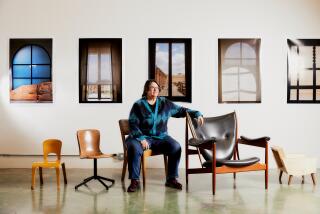FURNISHINGS : Something Wicker This Way Comes. . .
- Share via
Paula Olsson and Richard Saunders fell in love with their first piece of wicker furniture 22 years ago. They paid $5 for the rickety chair in a San Francisco store and carted it home in a cab.
“The ride was more than the chair,” Olsson recalls.
Because they were students on a tight budget at the time, Saunders decided to do the repairs. From little acorns, great oaks grow. Soon he had a part-time business repairing wicker. After college--he majored in creative writing--he wrote one of the first guides to wicker furniture.
These days, wicker is a full-time occupation for Saunders; Olsson shares her interest in it with a flower shop she owns.
They have about 75 pieces of wicker in their Pacific Grove house, including a porch swing hanging from the living room rafters. “Living With Wicker,” Saunders’ sixth book on the topic (co-authored by Olsson) has recently been published by Crown ($30), and Saunders is a well-known restorer and appraiser of antique wicker furniture.
Wicker is an umbrella term to describe all woven furniture made of natural materials such as rattan, reed, cane, willow and sea grass. Its heyday was from the 1880s to about 1920.
After languishing in attics and cellars for decades, wicker is enjoying a revival that has been growing over at least 10 years. It is found in homes ranging from authentically furnished New England saltboxes to minimalist modern structures--and in virtually every room.
These days, old wicker chairs rarely can be found for little more than pocket change. Curlicued wicker photographer’s chairs--so-called because they were photo props--might sell for $600 to $2,000. But wicker is still less pricey than other types of antique furniture.
For those who can’t find--or afford--the old stuff, there’s a raft of reproductions and adaptations, a number of which are of good quality.
For those who think of it merely as porch furniture, think again. An infant industry just before the Civil War, by the turn of the century wicker had become one of the most popular mass-produced furniture styles. Chairs, settees, sofas and chaises were the most desirable, but tables, etageres , bookcases, lamps, planters, headboards, cradles and baby carriages were common.
One of the oddest pieces known to exist is a player piano, apparently custom made in the 1920s. It is owned by a Texan who bought it at a country auction. Saunders owns a wicker hand-cranked phonograph, which dates from about 1915-25. There’s also a baby carriage shaped like a Model T Ford. Made by Heywood-Wakefield Co. of Gardner, Mass., in the early 1900s, each had a “license plate” with a different number.
A piece of old wicker furniture may look like an example of folk craft, but it isn’t. Manufacturing was highly organized, with a sophisticated division of labor, Saunders says, especially after the 1870s when a few large American companies such as Wakefield Rattan Co. and its main competitor, Heywood Brothers, sold their products worldwide. When the two companies merged in 1897 into the world’s largest manufacturer, there were scores of smaller companies mainly in the Northeast.
Saunders and Olsson consider the Victorian era, roughly 1870 to 1895, as a golden age in terms of variety and workmanship. The Victorians used wicker in every room. They painted it white or left it natural, gilded it or painted it dark red.
Many of the Victorian chairs, so awful they are wonderful, were considered too hideous even for the attic and were tossed out. Today, such styles are among the most sought, Olsson says.
A more rectilinear Mission-style wicker came into fashion from 1903 to 1917. This unornamented furniture was promoted by Gustav Stickley, the leader of the Arts and Crafts style in the United States, as a way to lighten rooms filled with dark oak furniture.
Bar Harbor wicker, porch furniture named for the Maine resort, was popular between 1915 and about 1930. The simple openwork chairs, rockers and settees are traditional at old-time seaside hotels.
In the 1920s, a machine known as the Lloyd loom dispensed with hand labor and natural materials and weaved wicker out of chemically treated paper. The furniture was cheaper but susceptible to moisture and wear. All of this, plus the perennial search for something new, led to its demise.
But what’s old is new once again, and wicker is reclaiming its place in the sun--and on the sun porch.
An exhibition tracing the history of the American wicker furniture industry is planned for the spring at the Renwick Gallery of the Smithsonian Institution in Washington, according to Saunders, a consultant to curator Jeremy Adamson.


